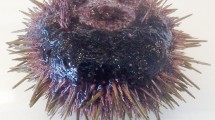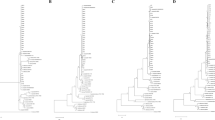Abstract
Scallops have become an important aquaculture species in China because they contain high-quality protein, and scallops are important health food that combines multiple effects and high economic benefits. However, scallop aquaculture is perennially threatened by various pathogenic Vibrio species, leading to great economic losses. We obtained a strain of pathogenic bacteria, identified as Vibrio alginolyticus, from the diseased Azumapecten farreri in the scallop farming area of Huangdao District in 2018, and V. alginolyticus is one of the major shellfish pathogens. We showed that V. alginolyticus was isolated and identified as a pathogen in A. farreri for the first time. In this study, we evaluated its morphology and performed a phylogenetic analysis based on 16S rRNA gene sequencing. In addition, we performed a preliminary analysis of its pathogenic mechanisms. The Hfq protein in V. alginolyticus is an important RNA-binding protein in the quorum-sensing system that not only affects the sensitivity of Vibrio to environmental stress but also regulates a variety of functions, such as cell membrane formation, motility, and virulence towards the host. However, its effect on the pathogenesis of V. alginolyticus to A. farreri is unclear. To further investigate the pathogenic mechanism of the Hfq protein in V. alginolyticus to A. farreri, we used the CRISPR-Cas9 system to target and deplete the hfq gene fragment in V. alginolyticus and obtained the mutant strain V. ΔHfq−. We found that the peripheral flagellum of the mutant strain was lost, which reduced the motility of V. alginolyticus. Therefore, the deletion of target genes by the CRISPR/Cas9 genome editing system confirmed that the Hfq protein played a key role in reducing the ability of V. alginolyticus to infect A. farreri. In conclusion, our current findings provided valuable insights into the healthy culture of scallops.






Similar content being viewed by others
Data availability statement
Some or all data, models, or codes generated or used during the study are available from the corresponding author by request.
References
Austin B (2010) Vibrios as causal agents of zoonoses. Vet Microbiol 140(3–4):310–317. https://doi.org/10.1016/j.vetmic.2009.03.015
Barrangou R, Doudna JA (2016) Applications of CRISPR technologies in research and beyond. Nat Biotechnol 34(9):933–941. https://doi.org/10.1038/nbt.3659
Bunpa S, Chaichana N, Teng JLL et al (2020) Outer membrane protein A (OmpA) is a potential virulence factor of Vibrio alginolyticus strains isolated from diseased fish. J Fish Dis. https://doi.org/10.1111/jfd.13120
Campanelli A, Sanchez-Politta S, Saurat JH (2008) Cutaneous ulceration after an octopus bite: infection due to Vibrio alginolyticus, an emerging pathogen. Ann Dermatol Venereol 135(3):225–227. https://doi.org/10.1016/j.annder.2007.04.010
Claudio M, Rober M, Fabienne L et al (2011) A novel TALE nuclease scaffold enables high genome editing activity in combination with low toxicity. Nucl Acids Res 39(21):9283–9293. https://doi.org/10.1093/nar/gkr597
Deng Y, Chen C, Zhao Z et al (2016a) The RNA Chaperone Hfq is involved in colony morphology, nutrient utilization and oxidative and envelope stress response in Vibrio alginolyticus. PLoS One 11(9):e0163689. https://doi.org/10.1371/journal.pone.0163689
Deng YQ, Zhao JJ, Liu SL et al (2016b) Role of Hfq in virulence regulation of Vibrio alginolyticus. Oceanol Limnol Sin 47(3):604–611. https://doi.org/10.11693/hyhz20160100022
El-Kurdi N, Abdulla H, Hanora A (2021) Anti-quorum sensing activity of some marine bacteria isolated from different marine resources in Egypt. Biotechnol Lett 43(2):455–468. https://doi.org/10.1007/s10529-020-03020-x
Elston R, Leibovitz L, Relyea D et al (1981) Diagnosis of vibriosis in a commercial oyster hatchery epizootic: diagnostic tools and management features. J. Aquac 24(none):53–62. https://doi.org/10.1016/0044-8486(81)90043-0
Emmanouilidis I, Fili N, Cook AW et al (2021) A targeted and tuneable DNA damage tool using CRISPR/Cas9. Biomolecules 11(2):288. https://doi.org/10.3390/biom11020288
Fang H, Bygrave AM, Roth RH et al (2021) An optimized CRISPR/Cas9 approach for precise genome editing in neurons. eLife Sci. https://doi.org/10.7554/eLife.65202
Feng YL, Liu SC, Chen RD et al (2021) Target binding and residence: a new determinant of DNA double-strand break repair pathway choice in CRISPR/Cas9 genome editing. J Zhejiang Univ Sci B 22(1):73–86. https://doi.org/10.1631/jzus.B2000282
Gaj T, Gersbach CA, Barbas CF (2013) ZFN, TALEN, and CRISPR/Cas-based methods for genome engineering. Trends Biotechnol 31(7):397–405. https://doi.org/10.1016/j.tibtech.2013.04.004
Huan L, Wang L et al (2020) Characterization of a cell density-dependent sRNA, Qrr, and its roles in the regulation of the quorum sensing and metabolism in Vibrio alginolyticus[J]. Appl Microbiol Biotechnol 104(4):1707–1720. https://doi.org/10.1007/s00253-019-10278-3
Jiang Y, Chen B, Duan CL et al (2015) Multigene editing in the Escherichia coli genome via the CRISPR-Cas9 system. Appl Environ Microbiol 81(7):2506. https://doi.org/10.1128/AEM.04023-14
Jinek M, Chylinski K, Fonfara I et al (2012) A programmable dual-RNA–guided DNA endonuclease in adaptive bacterial immunity. Science 337(6096):816–882. https://doi.org/10.1126/science.1225829
Joelsson A, Kan B, Zhu J (2007) Quorum sensing enhances the stress response in Vibrio cholerae. Appl Environ Microbiol 73(11):3742–3746. https://doi.org/10.1128/AEM.02804-06
Kawagishi I, Maekawa Y, Atsumi T et al (1995) Isolation of the polar and lateral flagellum-defective mutants in Vibrio alginolyticus and identification of their flagellar driving energy sources. J Bacteriol 177(17):5158–5160. https://doi.org/10.1128/jb.177.17.5158-5160
Lay ND, Schu DJ, Gottesman S (2013) Bacterial small RNA-based negative regulation: Hfq and its accomplices. J Biol Chem 288(12):7996–8003. https://doi.org/10.1074/jbc.R112.441386
Li QM, Zhu BB, Fang H et al (2017) Identification of pathogen of haemorrhagic disease of clam philippinosa. Shandong J Anim Sci Vet Med 38(010):7–8. https://doi.org/10.3969/j.issn.1007-1733.2017.10.004
Liu H, Wang Y; Cao J et al (2019) Antimicrobial activity and virulence attenuation of citral against the fish pathogen Vibrio alginolyticus. Aquaculture 515:734578. https://doi.org/10.1016/j.aquaculture.2019.734578
Liu H, Liu W, He XX et al (2020) Characterization of a cell density-dependent sRNA, Qrr, and its roles in the regulation of the quorum sensing and metabolism in Vibrio alginolyticus. Appl Microbiol Biotechnol 104(4):1707–1720. https://doi.org/10.1007/s00253-019-10278-3
Liu H, Wang Q, Qin L et al (2011) Roles of Hfq in the stress adaptation and virulence in fish pathogen Vibrio alginolyticus and its potential application as a target for live attenuated vaccine. Appl Microbiol Biotechnol 91(2):353–364. https://doi.org/10.1007/s00253-011-3286-3
Lombardo A, Cesana D, Genovese P et al (2011) Site-specific integration and tailoring of cassette design for sustainable gene transfer. Nat Methods 8(10):861–869. https://doi.org/10.1038/nmeth.1674
Maeder ML, Thibodeau-Beganny S, Osiak A et al (2008) Rapid “Open-Source” engineering of customized zinc-finger nucleases for highly efficient gene modification. Mol Cell 31(2):294–301. https://doi.org/10.1016/j.molcel.2008.06.016
Martin J et al (2012) A programmable dual-RNA–guided DNA endonuclease in adaptive bacterial immunity. Science 337:816–821. https://doi.org/10.1126/science.1225829
Miller JC, Tan S, Qiao G et al (2011) (2011) A TALE nuclease architecture for efficient genome editing. Nat Biotechnol 29(2):143–148. https://doi.org/10.1038/nbt.1755
Nielsen AT, Dolganov NA, Otto G et al (2006) RpoS controls the Vibrio cholerae Mucosal escape response. PLoS Pathog. https://doi.org/10.1371/journal.ppat.0020109
Rui HP, Liu Q, Ma Y et al (2008) Roles of LuxR in regulating extracellular alkaline serine protease A, extracellular polysaccharide and mobility of Vibrio alginolyticus. FEMS Microbiol Lett 285(2):155–162. https://doi.org/10.1111/j.1574-6968.2008.01185.x
Sakatoku A, Hatano K, Tanaka S et al (2021) Isolation and characterization of a Vibrio sp. strain MA3 associated with mass mortalities of the pearl oyster Pinctada fucata. Arch Microbiol 203:5267–5273. https://doi.org/10.1007/s00203-021-02457-6
Silva B, Hossain S, Dahanayake PS et al (2019) Vibrio spp. from Yesso scallop (Patinopecten yessoensis) demonstrating virulence properties and antimicrobial resistance. J Food Saf. https://doi.org/10.1111/jfs.12634
Thomason L, Court DL, Bubunenko M et al (2014) Recombineering: genetic engineering in bacteria using homologous recombination. Curr Protoc Mol Biol. https://doi.org/10.1002/0471142727.mb0116s70
Wang H, Yang H, Shivalila C et al (2013) One-step generation of Mice carrying mutations in multiple genes by CRISPR/Cas-mediated genome engineering. Cell 153(4):910–918. https://doi.org/10.1016/j.cell.2013.04.025
Weber B, Croxatto A, Chen C (2008) RpoS induces expression of the Vibrio anguillarum quorum-sensing regulator VanT. Microbiology 154(3):767–780. https://doi.org/10.1099/mic.0.2007/014167-0
Wege SM, Gejer K, Becker F et al (2021) Versatile CRISPR/Cas9 systems for genome editing in Ustilago maydis. J Fungi (Basel) 7(2):149. https://doi.org/10.3390/jof7020149
Wright AV, Nuñez JK, Doudna JA (2016) Biology and applications of CRISPR systems: harnessing nature’s toolbox for genome engineering. Cell 164(1–2):29–44. https://doi.org/10.1016/j.cell.2015.12.035
Xia J, Wang L, Zhu JB et al (2016) Expression of Shewanella frigidimarina fatty acid metabolic genes in E. coli by CRISPR/cas9-coupled lambda Red recombineering. Biotechnol Lett 38(1):117–122. https://doi.org/10.1007/s10529-015-1956-4
Yang H, Wang HY, Shivalila CS et al (2013) One-step generation of mice carrying reporter and conditional alleles by CRISPR/Cas-mediated genome engineering. Cell 154(6):1370–1379. https://doi.org/10.1016/j.cell.2013.08.022
Zhao YN, Ren JM, Jiang HY et al (2021) Metabolomics and lipidomics analyses delineating Hfq deletion-induced metabolic alterations in Vibrio alginolyticus. J Aquac 535:736349. https://doi.org/10.1016/j.aquaculture.2021.736349
Zhi W, Cai JP, Wen QB (2011) Isolation and characterization of Vibrio alginolyticus and its pathogenic effects on Postlarvae of Abalone Haliotis diversicolor supertexta. Mod Food Sci Technol (09):1169–1174. https://doi.org/10.13982/j.mfst.1673-9078.2011.09.001
Zhu H, Li C, Gao C (2020) Author correction: applications of CRISPR–Cas in agriculture and plant biotechnology. Mol Cell Biol 21(12):782–782. https://doi.org/10.1038/s41580-020-00312-y
Acknowledgements
This study was supported by the Key Research and Development Program of Shandong Province (No. 2019GHY112003), the National Key R&D Program of China (No. 2017YFC1404504), and the National Natural Science Foundation of Shandong Province (No. ZR2016DM18).
Author information
Authors and Affiliations
Contributions
We confirm that the manuscript has been read and approved by all named authors and that there are no other persons who satisfied the criteria for authorship but are not listed. We further confirm that the order of authors listed in the manuscript has been approved by all of us.
Corresponding author
Ethics declarations
Conflict of interest
The authors report that they have no conflicts of interest. The authors alone are responsible for the content and writing of this article.
Ethical approval
This study did not require ethics approval.
Additional information
Publisher's Note
Springer Nature remains neutral with regard to jurisdictional claims in published maps and institutional affiliations.
Supplementary Information
Below is the link to the electronic supplementary material.
Rights and permissions
Springer Nature or its licensor (e.g. a society or other partner) holds exclusive rights to this article under a publishing agreement with the author(s) or other rightsholder(s); author self-archiving of the accepted manuscript version of this article is solely governed by the terms of such publishing agreement and applicable law.
About this article
Cite this article
Ma, J., Zhang, P., Zheng, M. et al. A strain of Vibrio alginolyticus isolated from Azumapecten farreri and its pathogenic mechanism using CRISPR-Cas9 technology. Biotechnol Lett 45, 1279–1291 (2023). https://doi.org/10.1007/s10529-023-03394-8
Received:
Revised:
Accepted:
Published:
Issue Date:
DOI: https://doi.org/10.1007/s10529-023-03394-8




